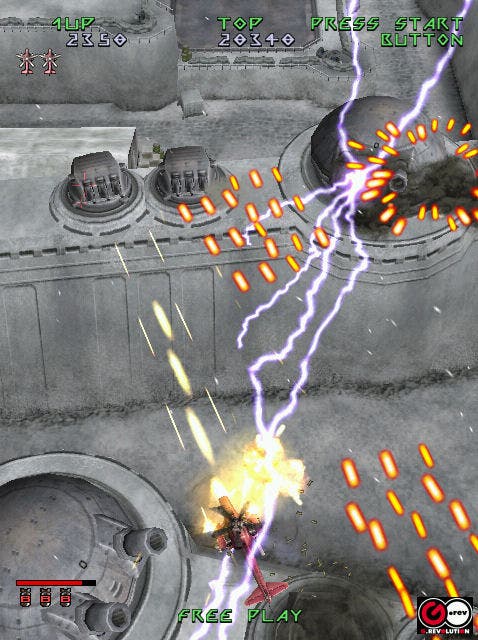Under Defeat
No, you're not dreaming.
If we had a new Dreamcast game for every time someone said, "That was definitely the last new Dreamcast game," we'd pretty much be in the situation we are now. Hrm. Anyway, Under Defeat is Japanese shoot-'em-up developer G.Rev's latest attempt at a eulogy for Dreamcast, a system still doggedly scratching at the inside of its coffin - at least in native Japan - five years and two months after Sega pulled the plug.
Despite the intervening years, the 98 vintage Dreamcast is still technically a current-gen machine. Indeed, as Under Defeat's helicopter gunship lurches across grey skies, blades nicking at swaying tree tops, a trail of black billowing callcards marking where each of your catastrophic explosions wrenched enemy gunship pilots into airborne oblivion, it's every inch pretty and PS2 - an enticing postcard from an alternative present where Sega hardware still matters.
Of course, it doesn't still matter one bit and to the vast majority of gaming's onward-marching consumers, Under Defeat is of no consequence - something hardly helped by its comprehensive lack of innovation or evolution. As traditional an expression of videogame's eldest genre as we've seen this century, Under Defeat dodges all its rivals' ideas with startling single-mindedness: no bullet hell (a la Ibara), no scrape bonus (Psyvariar), no learnable attack patterns (Gradius V), no augmentable main weapon (Radiant Silvergun), no 360-degree craft control (Zero Gunner 2), no delicately balanced multiplier (Radirgy) and all '80s muddy tanks, camouflage paint and white explosion.

Your main rail gun maintains the same pitch and power from start to finish as enemies aim straight for you. Four different option ships that can be deployed for a few seconds at a time to provide the only additional firepower and choice at your disposal. Each mixes up gameplay enjoyably and is different enough from the next to provoke experimentation from the player. The Vulcan cannon, for example, spits shots at a fast rate while the Rocket punches fire into the hull of a battle ship with its single battering shot. Score attack players are encouraged to pick up a hefty bonus by only collecting options of the same type.
Customisability outside of this is limited to two simple control styles switching how pressing left and right pivots your ship on its axis. The control methods are arguably split for offensive or defensive play but, as with FPS aiming controls, you'll likely just settle into the one that feels most natural to you and get on with it.
Your helicopter also comes with equipped with a couple of smart bombs of yore to wipe the screen clean of enemies and bullets when life is one pixel too far to the left of death. This showboats the real wonder of Under Defeat. It's looks have been lovingly chiselled from the unlockable drawing board sketches and each explosion sets off chains of background touches that will delight and excite both the Dreamcast apologist and player seeking an eye-candy rush.
Predictably for a conversion of a Japanese-only Naomi arcade title from such a small indie-studio, the Dreamcast bonuses are thin on the code. Each hour you play releases an extra credit until freeplay is eventually and begrudgingly wrestled from G.Rev's RSI-riddled fingers. There's a ton of artwork to be won for those excited by such trivia but, thankfully, the weight of gameplay and sprawling levels that take dedication and learning to inch forward through, provide the strongest argument for replay.

There is a little slowdown, particularly before your death (although perhaps that is intentionally stylistic), but the main problem here is one of merged technology. The game comes with both vertical and horizontal view mode options (in the arcade Under Defeat plays out on a vertically orientated monitor) but for everyone that doesn't have a TV they're willing to turn on its side, horizontal mode is the only meaningful choice here. Playing on a widescreen television in horizontal mode (with the obligatory black sidebars) squashes your view on the action considerably - a problem exacerbated by the 45-degree down-view on the action. For many Tate-orientated Shmups this isn't a problem but we had some difficulty seeing exactly what we were doing when things got heated.
That alternative present mentioned earlier - the one where Dreamcast still matters - plays host to a bristling underground fan scene. This hotchpotch culture of dewy-eyed geeks turns weak-kneed at the faintest opening strains of each new Dreamcast swansong rising from their import store's pre-order php. There's nothing necessarily wrong with that: the Shmup is the most painfully malnourished of gaming's orthodox genres and so fans take what they can. But it's important to realise that the scarcity of product and competition can cause both Dreamcast believers and Shmup aficionados to overstate the quality case; after all, complaining over scraps thrown from publishers' tables might just lead to plain starvation.
As a result Under Defeat's underground Internet love-in is undeniably overstated at grass roots. Inarguably, what Under Defeat does, it does very well. The execution is perfectly pitched and it clearly ticks each and every box the developers drew up on the ideas table. But it's hard to shake the feeling that this is '80s gaming dressed in '00s visuals running on '90s hardware. The gameplay is sweet and eloquent but, underneath it also tired and relentlessly derivative. Whether that annoys you or not depends on whether you were looking simply some well-made twitch fun or a glorious resurrection.

